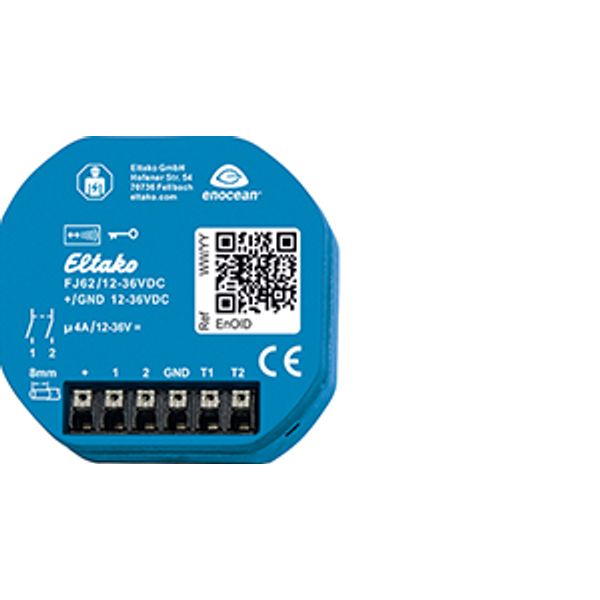Registruokitės, kad atrakintumėte savo išskirtines B2B kainas ir pradėtumėte apsipirkinėti. Užsiregistruokite dabar!
Wireless shading element and roller shutter actuator
Yra sandėlyje: Ne
Pardavėjo atsargos: Ne
Minimalus užsakymo kiekis: 1
Kaina (be PVM):
57,12 €
EAN: 4010312319406
MPN: 30200540
Pakuotė: 1
Numatomas pristatymo laikas į mūsų sandėlį (apytiksliai):
Pagal užklausą
Technical Information
| Prekės būklė | Nauja |
| Gamintojo pavadinimas | Wireless shading element and roller shutter actuator |
| Prekės ženklas | ELTAKO |
| Kategorijos |
Jungikliai
|
| Kilmės šalis | CN |
| Suderintos sistemos kodas | 8526 9200 00 |
| Montavimo metodas | Apatinis sluoksnis (tinko) |
| Spalva | Mėlynas |
| Be halogeno | Yes |
| Paviršiaus apdorojimas | Kita |
| Srovės tiekimas | Kita |
| Relių skaičius | 2 |
| Tinka jungikliui | Yes |
| Tinka impulsiniam mygtukui | Yes |
| Tinka tamsinimo sistemai | No |
| Tinka suvyniojamos uždangos jungikliui | Yes |
| Medžiagos kokybė | Termoplastikas |
| Medžiaga | Plastikinis |
| Tvirtinimo tipas | Kita |
| Ritininio kodo sistema | Yes |
| Komandų skaičius | 32 |
| Radijo dažnis | 868 MHz |
| Korpuse | Yes |
| Vamzdžio bazės korpuse | No |
| Štampuojama grandinės plokštė / modulis | No |
| Paspaudimo mygtuko režimas | Yes |
| Perjungimo režimas | Yes |
| Su rankiniu radijo siųstuvu | No |
| Su radijo kodavimo įrenginiu | No |
| Su radijo bangomis valdomu paspaudžiamu mygtuku | No |
| Tinka su pakeliamų žaliuzių / suvyniojamos uždangos jungikliu | Yes |
| Tinka pakeliamų žaliuzių uždangos jungikliui | Yes |
| Permatomas | No |
| Paviršiaus tipas | Kilimėlis |
| Tinka apsaugos laipsniui (IP) | IP20 |
| Galimas IFTTT palaikymas | No |
| Suderinamas su Apple HomeKit | No |
| Suderinamas su Google Assistant | No |
| Suderinamas su Amazon Alexa | No |
Pakavimo informacija
| Pakavimo lygis 1 | 4010312319406, 4010312319406 |
| Pakavimo lygis 2 | 4010312319406 |
| Pakavimo lygis 3 | 4010312319406 |
Atsisiuntimai
Aprašymas
Wireless shading element and roller shutter actuator 1+1 NO contact, 4A/36V DC, not potential free, for a shading element motor 12-36V DC. Standby loss only 0.3-0.5 watt. For installation. 49x51mm wide, 20mm deep. The terminals are plug-in terminals for conductor cross-sections of 0.2mm2 to 2.5mm2. The convenient tap technology permits the teach-in of up to 32 wireless universal pushbuttons, wireless direction pushbuttons and wireless central control pushbuttons. Bidirectional wireless switchable. Supply voltage, switching voltage and control voltage local 12-36V DC. If supply voltage fails, the device is switched off in defined mode. In addition to the wireless control input via an internal antenna, this wireless actuator can also be controlled locally by a conventional control switch if fitted previously. Control is either by separate local control inputs for Up and Down as direction pushbuttons or these two inputs are bridged and controlled by single pushbuttons as universal pushbuttons. A change in direction then takes place by interrupting activation. An incandescent lamp current is not permitted. Wireless pushbuttons can be taught in with either the functions Up-Stop-Down-Stop as universal pushbuttons or as local pushbuttons as well as a wireless pushbutton or roller shutter double pushbuttons can be taught in as direction pushbuttons with press top for Up and bottom for Down. Press briefly to stop the movement. In addition, the central control button can be taught in with static priority. The static priority is only active as long as the radio button is pressed. With a control signal, e.g. B. a radio transmitter module FSM61 with switches that has been taught-in as a central control button, the switching position Up or Down and the priority are specifically activated. With priority because these control signals cannot be overridden by other control signals until the central command is canceled again by the end of the control signal. The tap reverse function can be activated: universal pushbuttons, direction pushbuttons and wired pushbuttons are intially in static mode so that the position of the blind can be adjusted. Switched to dynamic only after activation > 1 second. With control via Professional Smart Home controller, operating commands for up and down with the exact travel time information can be started. As the actuator reports the exact elapsed time after each activity, even when driving was triggered by a pushbutton, the position of the shading is always displayed correctly in the Professional Smart Home controller. Upon reaching the end positions above and below the position is automatically synchronized. When a wireless window contact is taught in, a lockout protection is set up for open windows or doors to disable the Central Down and controller Down commands.

